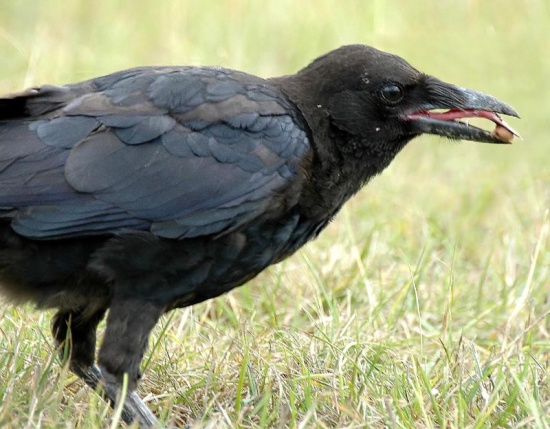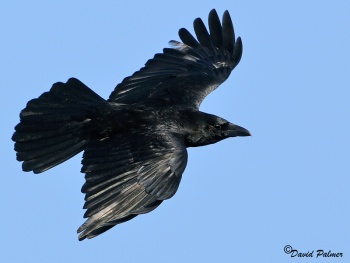
Alternative names: Common Crow; Eurasian Crow; Oriental Crow (orientalis)
- Corvus corone
Identification
48-54cm. A compact crow:
- All black plumage with a green or purple sheen
- Dark brown iris
- Black, stout bill
- Legs dark grey to black
Sexes similar, juveniles with duller plumage. Hybrids between corone and Hooded Crow occur regularly.
Similar species
Corone may be confused with young Rook. The shape of head and the flight are quite different.
Distribution
Most of western Europe to the most eastern points of northern Asia.
Common or abundant in most of its range despite persecution by gamekeepers and farmers.
Taxonomy
Was formerly considered conspecific with Hooded Crow.
Subspecies1
Two subspecies accepted:
Habitat
Found almost anywhere from coast to moorland, even city centres. 3
Behaviour
Ingenious adaption to all urban environments and intelligent. Can be observed sitting atop of trafficlights and dropping hardcased nuts onto the streets below so to make use of the crushing effects of traffic; and will retrieve the contents at a 'red' signal.
Diet
The diet includes carrion, insects, worms, seeds, fruit and scraps.
Breeding
Breeding season generally in northern spring. A pair stays often together over several years and throughout the year. Usually a solitary nester. The large nest is built by both sexes and is made out of sticks. It's usually placed high in a tall tree. Nests on buildings, electricity pylons or cliffs are also known. Lays 4 eggs. The chicks leave the nest after 32 days. In some parts of the range Great Spotted Cuckoo may parasitize the nest.
Vocalisation
<flashmp3>Corvus corone (song).mp3</flashmp3>
Listen in an external program
References
- Clements, James F. 2007. The Clements Checklist of Birds of the World. 6th ed., with updates to October 2007. Ithaca: Cornell University Press. ISBN 9780801445019
- Parkin, D.T., M. Collison, A. Helbig, A.G. Knox, and G. Sangster. 2003. "The taxonomic status of Carrion and Hooded Crows." British Birds. 96 (6): 274–90.
- RSPB
- Del Hoyo, J, A Elliott, and D Christie, eds. 2009. Handbook of the Birds of the World. Volume 14: Bush-shrikes to Old World Sparrows. Barcelona: Lynx Edicions. ISBN 978-8496553507
Recommended Citation
- BirdForum Opus contributors. (2024) Carrion Crow. In: BirdForum, the forum for wild birds and birding. Retrieved 19 April 2024 from https://www.birdforum.net/opus/Carrion_Crow
External Links
Threads about taxonomy of Hooded and Carrion Crow:
[1] and [2]




